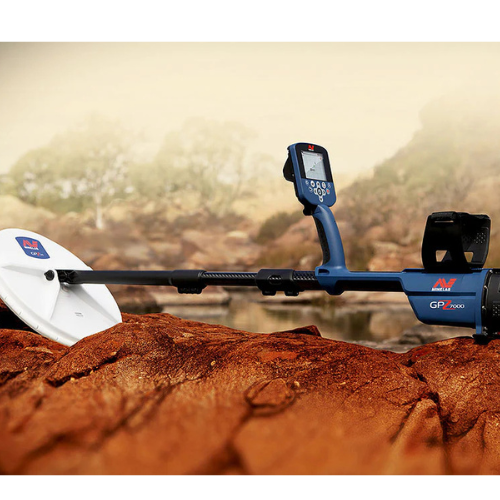Are you ready to embark on an adventure that could lead you to hidden treasures just waiting to be discovered? Welcome to "Unlocking Hidden Treasures: The Ultimate Guide to Finding Gold with a Metal Detector." In this comprehensive guide, we'll delve into the exciting world of metal detecting, showcasing not only the tips and tricks to maximize your chances of striking gold but also the thrill that comes with every dig. From selecting the right equipment to unearthing lost relics, this guide is your passport to uncovering the riches that lie beneath the surface. Whether you're a seasoned treasure hunter or a curious beginner, you'll find essential insights that will elevate your treasure-hunting game. So grab your metal detector, and let’s unlock the secrets of the earth together!
Understanding Gold and Its Value
Gold has fascinated humanity for millennia, symbolizing wealth, beauty, and power. Its allure is not merely aesthetic; gold's rarity and unique properties make it a prized possession. Unlike other metals, gold does not tarnish or corrode, making it an enduring asset. Throughout history, gold has been used in currency, jewelry, and various industrial applications due to its malleability and conductive properties. Discovering gold with a metal detector taps into this ancient quest for wealth, offering modern-day adventurers a chance to unearth historical treasures and natural gold deposits.
The value of gold fluctuates with market demand, influenced by economic stability, geopolitical events, and market speculation. As an investment, gold often serves as a hedge against inflation and currency devaluation. For treasure hunters, finding gold can be financially rewarding, but the thrill of discovery often surpasses monetary gain. Each nugget or artifact carries a story, connecting the finder to the past and to a timeless pursuit shared by countless generations.
Understanding the different forms of gold is crucial for a successful hunt. Gold can be found as nuggets, flakes, or dust in placer deposits, often in riverbeds and streams where erosion has concentrated the metal. It can also be located in hard rock deposits, requiring more advanced techniques to extract. By recognizing the various forms and their typical habitats, treasure hunters can tailor their approach, increasing their chances of striking gold.
Choosing the Right Metal Detector for Gold
Selecting the appropriate metal detector is a critical step in your gold-hunting journey. Not all metal detectors are created equal; some are specifically designed to detect gold, while others might be better suited for general metal detecting. Gold detectors typically operate at higher frequencies, which are more effective at picking up small gold nuggets and flakes. Popular models for gold detecting include the Minelab Gold Monster 1000, Minelab GPX 6000, Nokta Makro Legend, XP Deus II and Minelab GPZ 7000 each offering unique features to enhance your search.

When choosing a metal detector, consider factors such as sensitivity, discrimination, and ground balance. Sensitivity refers to the detector's ability to pick up small targets, which is essential for finding tiny gold particles. Discrimination allows the detector to differentiate between gold and other metals, reducing the number of false signals. Ground balance helps the detector cope with mineralized soil, which can interfere with the detection of gold. Many modern detectors offer automatic ground balancing, making them user-friendly for beginners.
Budget is another crucial consideration. While high-end detectors offer advanced features and greater sensitivity, they come at a higher cost. For those new to gold detecting, starting with a mid-range detector can provide a good balance between performance and affordability. As you gain experience and confidence, you might choose to invest in a more sophisticated model. Regardless of your choice, ensure that your detector is designed for gold prospecting to maximize your chances of success.
Essential Gear and Accessories for Gold Hunting
In addition to a metal detector, several other tools and accessories are essential for a successful gold-hunting expedition. A good quality shovel and digging tool are indispensable for recovering targets. Look for sturdy, lightweight options that can withstand tough conditions. A small hand trowel can be useful for more precise digging, while a larger shovel is ideal for deeper targets.
A pinpointer is another valuable accessory, helping you locate the exact position of a target once your detector has identified it. This handheld device saves time and effort by reducing the amount of soil you need to sift through. Investing in a durable, waterproof pinpointer can also be beneficial, especially when searching in wet or muddy environments.
Carrying a finds bag or pouch allows you to keep your discoveries safe and organized. Choose a bag with multiple compartments to separate trash from treasure and ensure it is comfortable to wear for extended periods. Additionally, a good pair of gloves can protect your hands from sharp objects and rough terrain while digging.
A gold pan is also a handy tool, especially when prospecting near water sources. It allows you to separate gold from other materials using water and gravity. Panning is a traditional method that can still yield impressive results, particularly in areas known for placer deposits. Lastly, ensure you have a reliable map and a compass or GPS device to navigate and record your search areas accurately.
Researching Locations for Gold Detection
One of the most critical aspects of successful gold hunting is selecting the right location. Researching potential sites can significantly increase your chances of finding gold. Historical records, old maps, and geological surveys are valuable resources for identifying areas with a history of gold production. Libraries, online databases, and local historical societies can provide access to such information.
Understanding the geology of a region is also essential. Gold is often found in areas with specific geological formations, such as quartz veins or alluvial deposits. Studying geological maps and reports can help you identify promising locations. Pay attention to areas with known gold occurrences, as these can indicate the presence of undiscovered deposits. Additionally, consider the natural processes that concentrate gold, such as erosion and sedimentation, which can create rich placer deposits in riverbeds and floodplains.
Networking with other treasure hunters and joining metal detecting clubs can provide valuable insights and tips on productive locations. Experienced hunters often share their knowledge and may even invite you to join them on expeditions. Online forums and social media groups dedicated to metal detecting and gold prospecting can also be valuable sources of information and support. By leveraging the collective wisdom of the community, you can discover new sites and refine your search strategies.
Techniques for Effective Gold Prospecting
Effective gold prospecting requires a combination of skill, patience, and technique. Start by thoroughly scanning the area with your metal detector, using a slow and methodical sweep pattern. Pay attention to the detector's signals, and take your time to investigate any potential targets. Overlapping your sweeps ensures you cover the area comprehensively and reduces the chances of missing small nuggets.
Adjusting the settings on your metal detector can also improve your results. Fine-tune the sensitivity and ground balance to suit the specific conditions of the site. In highly mineralized soil, reducing the sensitivity slightly can help filter out false signals. Experiment with different discrimination settings to find the optimal balance between detecting gold and ignoring unwanted metals.
Once you receive a signal, use your pinpointer to locate the target more precisely. Carefully dig around the signal, and sift through the soil to recover the object. Be methodical and patient, as rushing can lead to missed targets or damaged finds. When searching in water, use a gold pan to separate gold from other materials. Swirl the pan gently to allow the heavier gold to settle at the bottom while lighter materials wash away.
Persistence and perseverance are key to successful gold prospecting. It may take time and effort to find your first nugget, but each discovery builds your skills and confidence. Keep detailed records of your searches, noting the locations, conditions, and results. This information can help you identify patterns and refine your techniques over time.
Tips for Maintaining Your Metal Detector
Proper maintenance of your metal detector is essential to ensure its longevity and optimal performance. Start by regularly inspecting your detector for any signs of damage or wear. Check the coil, cables, and connectors for cracks or fraying, and replace any damaged parts promptly. Keeping your equipment in good condition will help you avoid malfunctions in the field and extend the life of your detector.
Cleaning your metal detector after each use is crucial, especially if you've been detecting in harsh environments such as saltwater or highly mineralized soil. Use a soft cloth to wipe down the detector, removing dirt and debris. For the coil, a gentle rinse with water can help remove any stuck-on particles. Avoid using harsh chemicals or abrasive materials, as these can damage the detector's components.
Storing your metal detector properly when not in use is equally important. Keep it in a cool, dry place, away from direct sunlight and extreme temperatures. If possible, store the detector disassembled, with the coil and control box separated. This prevents unnecessary strain on the cables and connectors. Using a protective carrying case can provide additional protection during storage and transportation.
Regularly updating the firmware on your metal detector, if applicable, can enhance its performance and introduce new features. Manufacturers often release updates to improve detection capabilities and address any issues. Refer to the user manual and the manufacturer's website for instructions on how to check for and install updates.
Legal Considerations and Permissions for Metal Detecting
Before embarking on your gold-hunting adventure, it's essential to understand the legal considerations and obtain any necessary permissions. Metal detecting is subject to various regulations, which can vary significantly depending on the country, state, or local jurisdiction. Researching and complying with these regulations is crucial to avoid legal issues and ensure responsible detecting.
In many areas, detecting on private property requires the landowner's permission. Always seek explicit consent before entering private land, and respect any conditions they may impose. Written agreements can help clarify the terms and protect both parties. When detecting on public land, such as parks, beaches, or forests, check with the relevant authorities for any restrictions or permits required. Some locations may have designated areas for metal detecting, while others may prohibit the activity altogether.
Certain sites, such as historical landmarks, archaeological sites, and protected areas, are typically off-limits to metal detecting. Disturbing these areas can result in severe penalties and damage to cultural heritage. Respecting these restrictions is essential to preserving history and ensuring the future of metal detecting as a hobby. When in doubt, consult with local historical societies or government agencies to determine the status of a site.
In some regions, there are specific regulations regarding the discovery of valuable items, such as gold or historical artifacts. You may be required to report significant finds to authorities or share them with the landowner. Familiarize yourself with these rules and adhere to them to avoid legal complications. Responsible detecting also involves following ethical practices, such as filling in holes after digging and removing trash from the environment.
Success Stories: Inspiring Finds and Adventures
The world of metal detecting is filled with inspiring stories of remarkable discoveries and thrilling adventures. From ancient coins and historical artifacts to sizable gold nuggets, these success stories fuel the passion of treasure hunters and demonstrate the potential rewards of perseverance and skill.
One such story is that of Kevin Hillier, an Australian prospector who discovered the "Hand of Faith" nugget in 1980. Weighing a staggering 875 troy ounces (27.21 kg), it is the largest gold nugget found with a metal detector. Hillier's find, buried just a few inches below the surface, was a life-changing event, highlighting the incredible possibilities that metal detecting offers.
In the United States, the discovery of the "Boot of Cortez" nugget in 1989 is another legendary tale. Found in Mexico by a local prospector using a metal detector, this gold nugget weighs 389 troy ounces (12.11 kg) and is renowned for its unique shape and size. The nugget was later sold at auction for a substantial sum, underscoring the financial rewards that can accompany significant finds.
Historical artifacts also feature prominently in the annals of metal detecting. In 2009, British detectorist Terry Herbert discovered the Staffordshire Hoard, the largest collection of Anglo-Saxon gold and silver metalwork ever found. Unearthed in a field in Staffordshire, England, the hoard comprises over 3,500 items, including weapons, jewelry, and religious artifacts. The discovery provided invaluable insights into Anglo-Saxon history and craftsmanship, earning Herbert widespread acclaim.
These success stories serve as powerful motivators for aspiring treasure hunters. They illustrate the potential for life-changing discoveries and the profound connection to history that metal detecting offers. Each find, whether modest or monumental, adds to the rich tapestry of human history and fuels the ongoing quest for hidden treasures.
Conclusion and Next Steps for Aspiring Gold Hunters
Embarking on the journey of gold hunting with a metal detector is an exciting and rewarding endeavor. With the right knowledge, equipment, and techniques, you can increase your chances of discovering hidden treasures and experiencing the thrill of unearthing gold. This comprehensive guide has provided you with essential insights into understanding gold, choosing the right metal detector, gathering necessary gear, researching locations, and employing effective prospecting techniques.
As you venture into the world of metal detecting, remember that patience and persistence are key. Each outing is an opportunity to learn and hone your skills, bringing you closer to your first significant find. Engage with the metal detecting community, share your experiences, and seek advice from seasoned hunters. Their collective wisdom can provide valuable guidance and support.
Always respect legal considerations and ethical practices, ensuring that your detecting activities are responsible and sustainable. By doing so, you contribute to the preservation of history and the environment, fostering a positive image of metal detecting as a hobby.
Whether you are a seasoned treasure hunter or a curious beginner, the journey of finding gold with a metal detector is filled with adventure and discovery. So grab your metal detector, head out into the field, and unlock the hidden treasures that lie beneath the surface. The next great find could be just a beep away, waiting for you to uncover its secrets and add your story to the annals of metal detecting lore.




Dejar un comentario